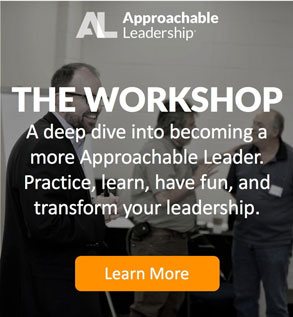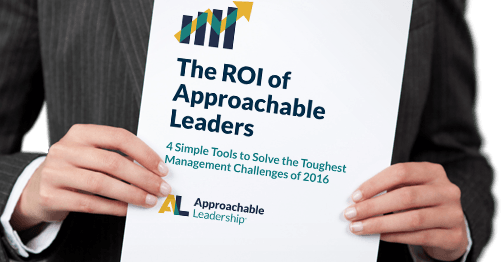A Day in the Life of an Approachable Leadership Workshop
Can you teach someone to be more approachable?
Almost every time I speak about approachability I’m asked some version of this question: “We’ve got several supervisors who are technically great, but terrible with people. Can you actually train someone like that to be more approachable?”
I’m happy to say the answer is yes. That’s what we do.
Look, we’re not sprinkling magic leadership dust on people. Some struggle more with approachability than others. And, of course, some refuse to do the work to change their leadership style. But we’ve seen some amazing transformations. If they’re willing to do the work, any leader can improve their relationships by working on the skills and behavior we teach in our workshops.
This often begs the next question: How? What specifically do we do during our workshops and follow-up training that builds new leader behavior?
In all of my evangelizing on Approachable Leadership, I don’t think I’ve ever provided a blueprint of an Approachable Leadership Workshop. Today, I’m fixing that. I thought it would be helpful to walk through a “day in the life” of one of our workshops to help folks understand exactly how we do what we do.
Here’s an outline of a typical Approachable Leadership Workshop. If you’ve been following us for any length of time, you should recognize many of the concepts. We break them down regularly on our blog. As you read through the outline, if a particular tool or piece of subject matter stands out to you, click on the link and it will take you to a post or page on our site that explains the idea a little further.
*** APPROACHABLE LEADERSHIP WORKSHOP BEGINS ***
ICEBREAKER EXERCISE
We kick off with our Everyday Leaders exercise. Here each trainee identifies an important leader in their own life. Most people choose an influential work leader, but it’s not unusual for someone to pick a parent, grandparent, sibling or teacher. We then ask them to reflect on the key behaviors that stand out about that person’s leadership (sometimes these are emotional – showing right away the power of being vulnerable with others). After discussing these behaviors, we then dramatically reveal how these behaviors relate to each trainee’s personal leadership. Finally, we encourage trainees to reach out to their leader and tell them, “I thought about you today when asked about an important leader in my life.” We often get feedback about the incredible conversations this simple act of gratitude triggers.
LEARNING OBJECTIVES:
Next, we quickly go over the learning objectives for the day:
- Learning Objective 1: Value approachability in life and work;
- Learning Objective 2: Recognize approachable and unapproachable behavior in yourself and others;
- Learning Objective 3: Learn basic skills and behaviors of Approachable Leaders;
- Learning Objective 4: See approachability as a “practice” that applies in all relationships.
SECTION 1: POWER DISTANCE
POWER DISTANCE: This section covers the foundational idea of Power Distance. We teach this section using poignant stories (each trainer brings in their own personal experiences, but when I teach I tell a story about my daughter). We show the Hofstede Power Distance Diagram to help learners visualize the idea. We then share the powerful story of the crash of Air Florida Flight 90 which learners will never forget. Our goal here is to create an emotional hook that builds the case for just how critical it is that leaders seek to shrink power distance with their teams. We vividly illustrate that this can be a matter of life or death.
TOOL: We introduce our Recognizing Gaps Tool and explain how learners can start using it right away (in fact, they get to use it during the next exercise!)
EXERCISE: Next, we do our popular Just Right Exercise (we’ve actually had strangers walk into our training room to find out what’s happening because people are laughing and having so much fun!) Our exercises need to be experienced in the moment so I’m not going to reveal all the details. But the key idea for this exercise is for learners to role-play what it feels like to behave in an unapproachable way and then what it feels like to be on the receiving end of an unapproachable leader. We later experience what it feels like to be with an inauthentic (overly nice) leader. Then we experience the same situation with a leader who handles things “just right.” This exercise gives learners very practical examples of right and wrong behavior that they can look back on as they reflect on the training and their own leadership.
SECTION 2: OPENNESS AND RIGHT SPACE
MOTIVATION-ORGANIZATIONAL CITIZENSHIP: Before we dig into our first “pillar” of the Approachable Leadership Model we teach one other chunk of content on how people are REALLY motivated. This section introduces some powerful research on the importance of Organizational Citizenship Behavior (OCB) and how Approachable Leaders drive these important behaviors every day.
TOOL: The tool for this section is our Approachable Leadership Model. This illustrates each of the three “pillars” of leadership and the important goal of increasing connection with your team.
OPENNESS-RIGHT SPACE: Here we teach the concept of leadership “curb appeal” and the importance of creating the right space with our team. Leaders share how they create space. To create an emotional hook for this section we learn about the terrible challenges of medical mistakes and how one simple “curb appeal” behavior saves hundreds of thousands of lives each year. We then learn the 4 magic words of leadership (sorry, not revealing them here – you’ll have to come to class to learn them J
TAKEAWAY-COMMITMENT: We close out the learning on Openness and Right Space (like we do with each “pillar”) with a takeaway and commitment exercise. Each learner identifies the key takeaway from this section of the learning and commits to take one action over the next month related to this section of the training. This is a key component of how the learning continues after the training session is over. Then we turn to the next “pillar” of the training.
SECTION 3: UNDERSTANDING AND RIGHT FEELING
APPROACHABILITY WINDOW: The next section of training contains two learning chunks I hear most often when learners reveal their top takeaways for the day. First, we teach the Approachability Window, which explains our simple model for growing solid relationships. Who knew that the legal principles for negotiating a binding contract could actually help someone remember the right way to connect with others?
EXERCISE: Learners love our Approachability Window exercise. During this experience each person quickly gets to give and receive feedback using what they just learned. Then there is a surprise “twist” to the exercise that ups the ante and really gives people a chance to up their approachability game. This is consistently rated as a highlight from the day.
TOOL: The tool for this section is our Approachability Window Cards. This deck of cards is what learners use to do the exercise. As a bonus, learners walk out of the room with these cards. They provide a great structured way to give and receive feedback from their teammates and even their boss.
STOP-LISTEN-CONFIRM: We next turn to one of the leading management thinkers of the 20th Century (and another surprising source of management advice who is NOT one of the leading management thinkers of ANY century). Here we learn our Stop-Listen-Confirm+Collaborate model for handling important conversations. Learners are taught an important “bran hack” that prevents leaders from jumping into “solve-it” mode too quickly. Many learners feel like this is the most practical, important tool they can start using immediately to improve relationships with their team (and their family!)
TAKEAWAY-COMMITMENT: We close out the learning on Understanding and Right Feeling with another takeaway and commitment exercise. Again, each learner identifies the key takeaway from this section of the learning and commits to take one action over the next month related to just this section of the training. Then we turn to the third “pillar” of the training.
SECTION 4: SUPPORT
FOLLOW-UP and FOLLOW-THROUGH: The learning content on the third “pillar” of Support and Right Action covers the 6 key areas for building an effecting follow-up and follow-through system. Learners are introduced to the concept of follow-up “rules and tools” and spend some time discussing their go-to rules and tools with each other.
EXERCISE: The exercise here is a brainstorm about “rules and tools” that learners rely on in their own system for execution. This robust discussion often gives learners the chance to see how some of their peers structure follow-up and follow-through in their own work lives. Often learners discover a handful of new rules and tools that they want to try in their own system.
TOOL: We then introduce the Action+Leadership Journal to learners, which is our own system for follow up and follow through. This Journal is another tool learners can consider adding to their system. Each learner already has one in their hands (the workbook they use during the training also contains an Action+Leadership Journal).
TAKEAWAY-COMMITMENT: You probably guessed this already, but we close out the learning on Support and Right Action with another takeaway and commitment exercise. Each learner once again identifies the key takeaway from this section of the learning and commits to take one action over the next month related to just Support and Right Action.
SECTION 5: THREE QUESTIONS THAT WILL TRANSFORM YOUR LEADERSHIP (AND YOUR LIFE)
THREE QUESTIONS THAT WILL TRANSFORM YOUR LEADERSHIP (AND YOUR LIFE): We finish up the learning by teaching three simple questions (and the three key assumptions) that leaders can begin using the moment they leave the training. These questions will transform work and personal relationships. Through a quick series of poignant stories and eye-opening studies, we teach these three questions and assumptions:
- Do You Have What You Need? (Hero Assumption)
- What Would Make Work Better? (F-Word of Leadership, PITA Principle)
- What’s Next? (The Progress Principle)
In addition to learning the three questions, we teach how being more approachable will positively impact each person in the room. This is the WIIFM (What’s In It For Me?) segment of the training. We reveal research to learners about how they’ll make more money, live longer and happier, and even have a better love life if they become more approachable. While this is all done in a fun, tongue-in-cheek fashion, the research is real. This provides several more personal reasons a learner will want to put the lessons of the day to work in their lives.
TAKEAWAY-COMMITMENT: Before we complete the final takeaway and commitment exercise we hit learners with the cold, hard facts: many of them will forget what they learned today. That’s not the worst news. Even those who decide to try out some of their new skills are likely to get push-back from the teammates who might need an approachable leader the most. We do this to make sure learners truly commit to work on their key takeaway and not give up if things don’t go perfect out of the gate. Each learner then identifies their ONE key takeaway from the day. They can choose to work on more, but they COMMIT to the group that they will follow up on one key learning from the day.
FINAL WRAP UP AND SHARING TOP TAKEAWAYS: We finish the half-day workshop with each person sharing their top takeaway commitment. This is a great way to review all the key learnings (typically every key topic comes up at least once). It also creates a formal, public commitment so others can help hold you accountable.
*** APPROACHABLE LEADERSHIP WORKSHOP ENDS ***
I feel very lucky that I get to spend so much of my time spreading the message of Approachable Leadership. But nothing gets me as amped up as when one of our team is delivering the Approachable Leadership Workshop.
Being in an environment where we get to work side-by-side with leaders and help them overcome some of the challenges they face is a real gift. It is a privilege to see people connect these leadership concepts with their day-to-day leadership. We also know we are positively impacting every single person these leaders lead. That multiplier effect is a huge motivator for us. Plus, each new group of leaders come unique experiences that help us refine our own understanding of leading in today’s world.
Interested in learning more about our Workshop? Check out this page to learn more and to read some of the reviews we’ve received. Or better yet! Call me directly at 800-888-9115. I’d love to talk about how we can bring the Approachable Leadership Workshop to your crew.










